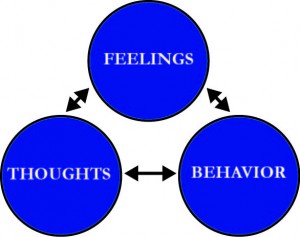The Three-Component Model
The science of anxiety can be complex. Luckily, there is a model we use in CBT to help us keep our bearings.
Most anxiety problems consist of three components:
- Feelings: Research suggests that feelings are anxiety’s core — the part that presidents share with penguins. There are two subtypes of anxious feelings.
- Emotion: keyed-up apprehension or dread
- Physical sensations: e.g., muscle tension and dizziness*
- Thoughts: Thoughts also play a major role in anxiety issues. Two thinking errors are especially important: overestimating the chances of bad things happening and underestimating our ability to cope with it.
- Behavior: Behavior transforms anxiety into anxiety problems, and avoidance is the behavior that drives this transformation.
The three components work together in a coordinated dance. Anxious feelings lead to anxious thoughts. Anxious thoughts lead to anxious feelings. And avoidant behavior acts as the glue, holding the problem together.
*Panic attacks involve other physical sensations, such as shortness of breath, accelerated heart rate, sweating, shaking, and chest pain.
Dylan M. Kollman, PhD
dkollman@realanxietysolutions.com







